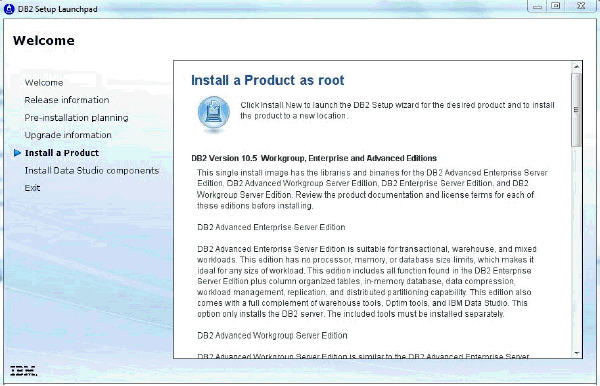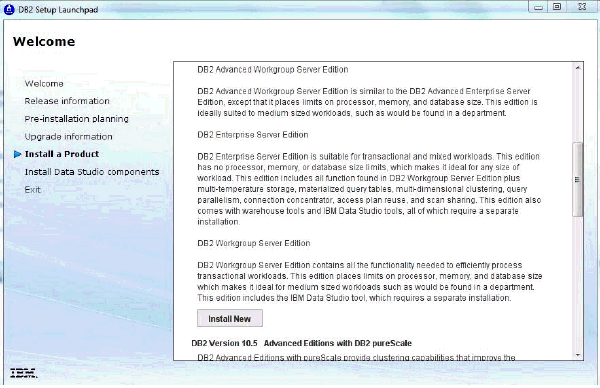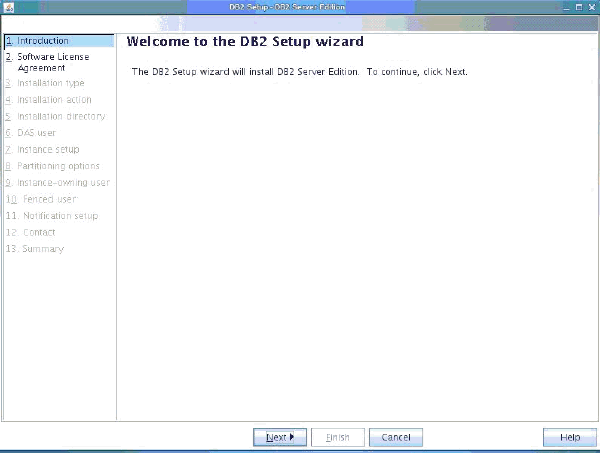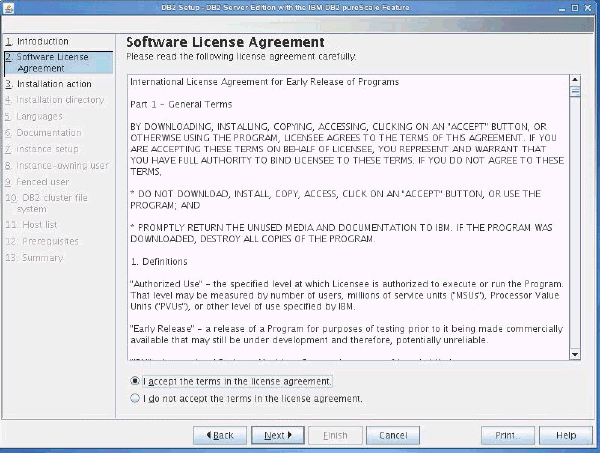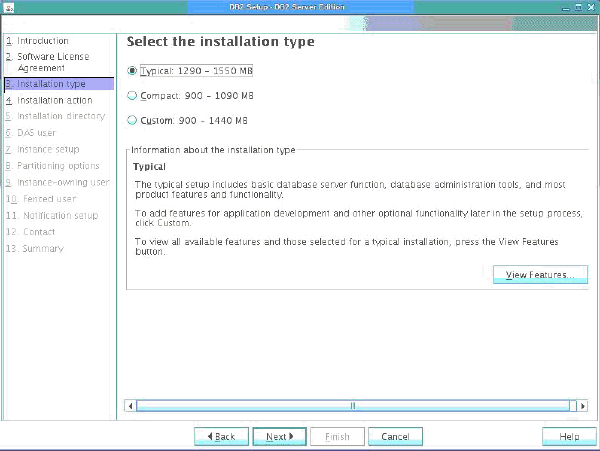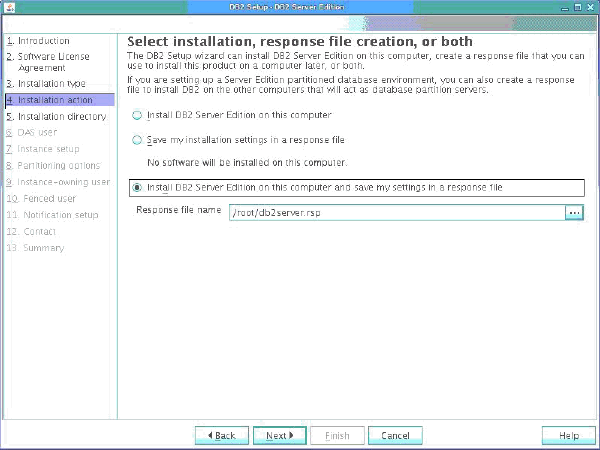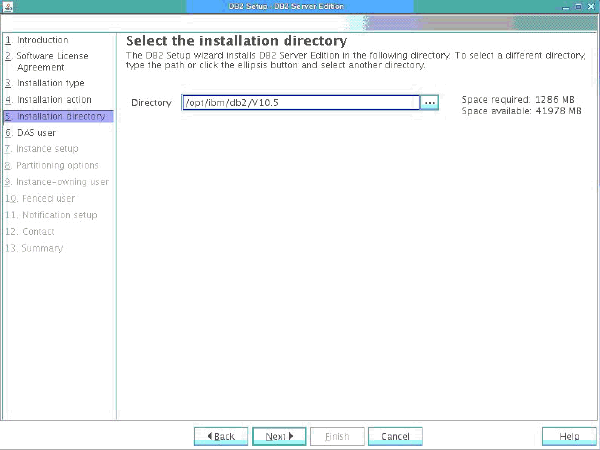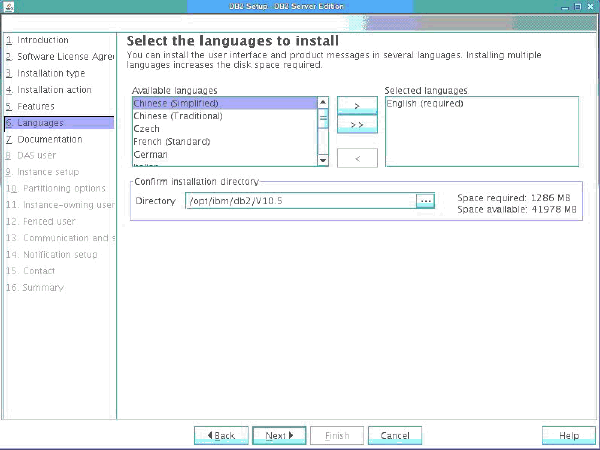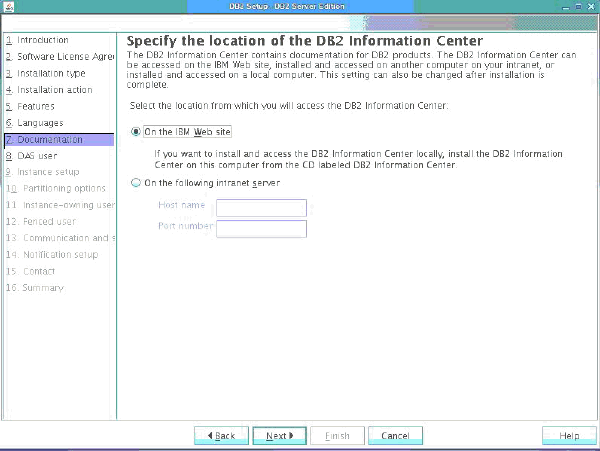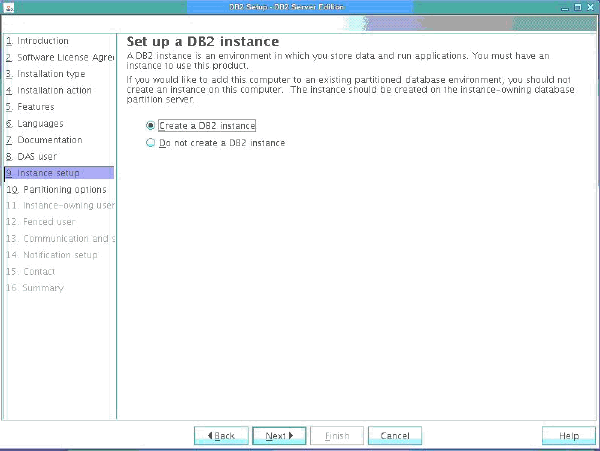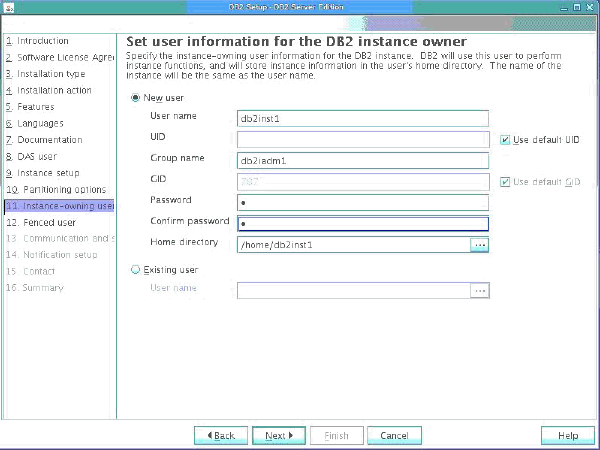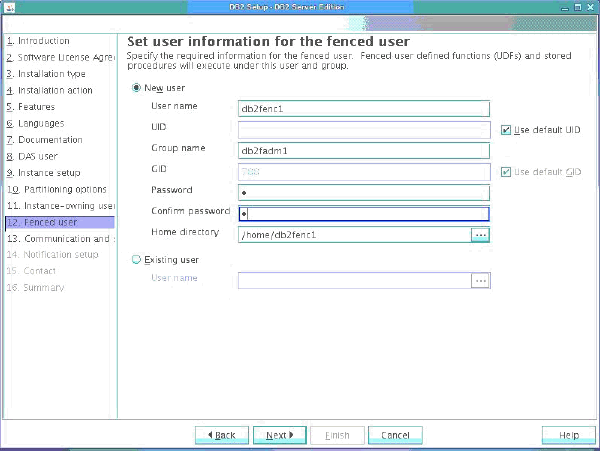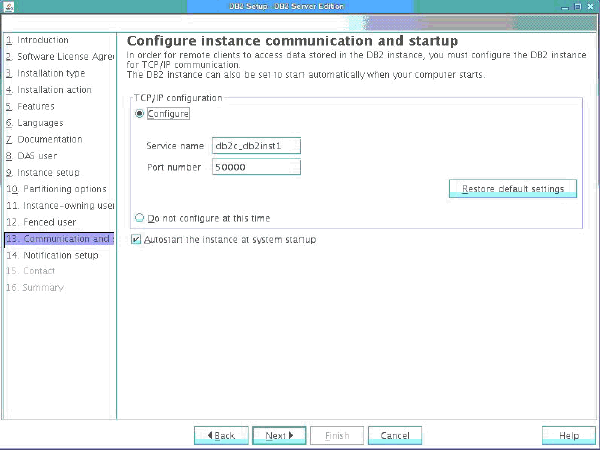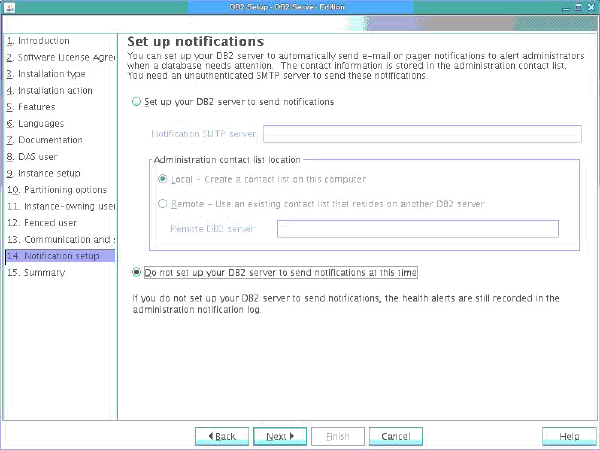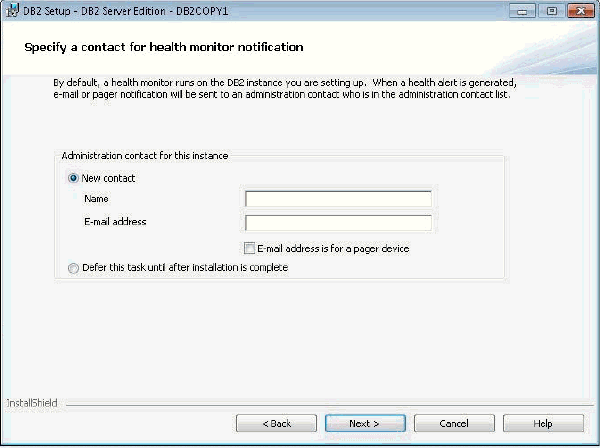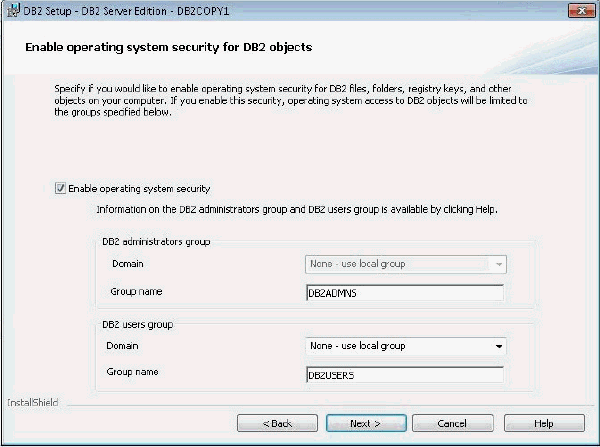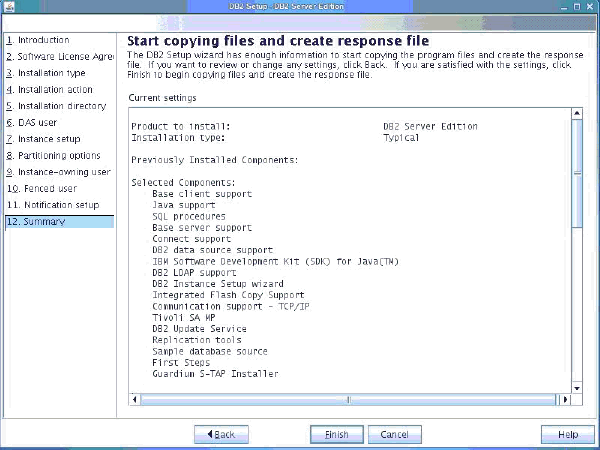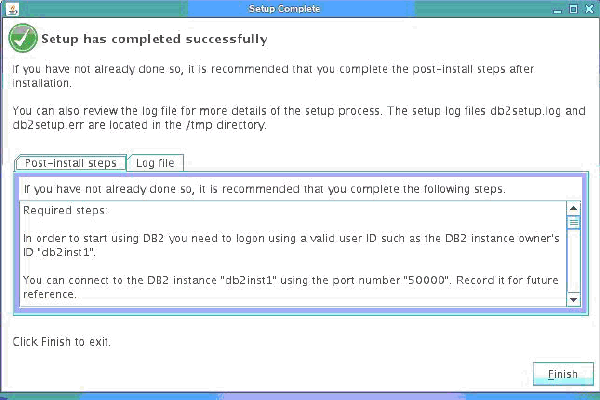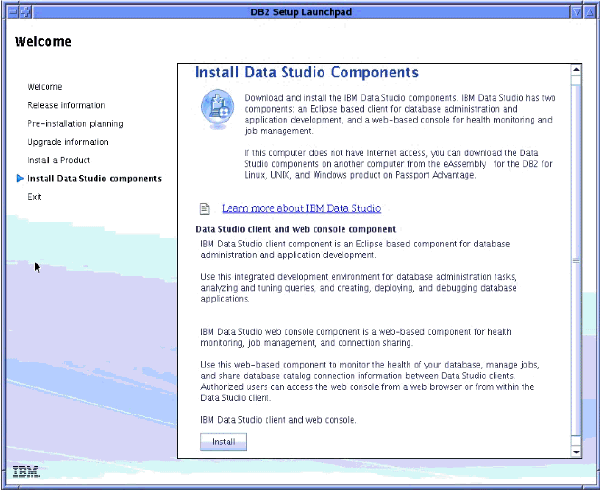When you install DB2® Enterprise
Server Edition using
the DB2 Setup wizard, there
are several panels. The following leads you through these panels.
Before you begin
Before starting the
DB2 Setup wizard,
check the installation prerequisites by using the
db2prereqcheck command.
Procedure
- Start the DB2 Setup wizard by running
the db2setup command from the directory where the DB2 installation image is located:
./db2setup -l /tmp/db2setup.log -t /tmp/db2setup.trc
The -l and -t parameters
enable DB2 logging and tracing.
The IBM DB2 Setup Launchpad opens. From this
window, you can view the DB2 pureScale® Feature release
information, upgrade options, architectural overview, and pre-installation
planning, or you can proceed directly to the installation.Figure 1. DB2 Setup
Launchpad
- To install a DB2 product,
click Install a Product. The Install
a Product panel displays. This window displays the products
available for installation.
Figure 2. Install
a Product window
Click Install New under DB2 Version 10.5 Workgroup, Enterprise and Advanced
Editions. Installation help can guide you through each of the installation
panels. To invoke the installation help, click Help or
press F1. You can click Cancel at
any time to end the installation. The Welcome Panel displays.
- The Welcome Panel. This panel displays
the DB2 product that you chose
to install.
Figure 3. DB2 Setup wizard Welcome Panel
To end the installation, you can click Cancel at
any time.Click Next to continue.
- The Software License Agreement Panel.
This panel displays the licensing terms.
Figure 4. Software License Agreement Panel
After reviewing the software licensing agreement, select Accept to
accept the terms.Click Next to continue.
- The Select the installation type Panel.
On this panel, you specify the type of installation to perform. You
can also view the DB2 offerings to be installed.
Figure 5. Select the installation type Panel
You can use the DB2 Setup
wizard to specify:- The typical setup includes basic database server function,
database administration tools, and most product offerings and
functionary. To add offerings for application
development and other optional functionality later in the setup process,
select Custom.
- The Compact setup includes basic DB2 offerings and functionality, and minimal configuration
is performed.
- For Custom setup, if you are already familiar with DB2 offerings and
settings, you can select offerings that you
want installed and specify your configuration preferences. The default
settings for a custom installation are similar to the typical installation
type, but you can customize optional offerings and
configuration parameters.
- If you choose to set up using a default setting, you must
specify the Typical field.
To view the offerings to be installed,
click View Features. The View Features dialog
box opens and displays the offerings to be
installed.Installation help can guide you through each of the installation
panels. To invoke the installation help, click Help or
press F1.
Click Next to
continue.
- The Select installation, response file creation,
or both Panel. From this panel, you can choose to perform
the installation now or, save the installation settings to a response
file for installation later or, perform both (perform the installation
now and save the installation settings to a response file).
Figure 6. Select installation, response file creation,
or both Panel
You can use the DB2 Setup wizard to do
the following: - Install the product. When you are finished stepping through
the DB2 Setup wizard, your DB2 database product is installed on your system.
Response file is not saved.
- Create and save the installation settings in a response file,
but not install the product. You can use this response file to install
this product later. The DB2 database
product is not installed. The DB2 Setup wizard
only generates the response file that is based on your selections.
- Install the product and create and save a response file that
you can use as a record of your choices.
If you choose to create a response file, you can specify the
name and location of the response file in the Response
file name field. This same response file can be updated
to use on another set of hosts as well.Click Next to
continue.
- The Select installation directory Panel.
On this panel, you specify the directory where you want to install
your DB2 database product.
Figure 7. Select installation directory
Panel
To view the disk space that is required for the installation
of the selected offerings click Disk
space. The Disk Space Requirement dialog box opens and
displays the available disk space for the currently selected offerings.Click Next to
continue.
- Select the language to install Panel.
Figure 8. Select the language to install
Panel
Specify the directory path where you want to install your DB2 languages. Click Next to
continue.
- Specify the location of the DB2 Information Center
Panel
Figure 9. Specify
the location of the DB2 Information
Center Panel
Specify the directory path of your DB2 Information
Center. You can select the IBM website or specify the intranet server with
the host name and port number.Click Next to
continue.
- Set up a DB2 instance Panel.
Figure 10. Set up a DB2 instance
Panel
Use this panel to create a DB2 Enterprise
Server Edition instance. - To create a DB2 instance,
select Create a DB2 instance.
- If you do not want the DB2 Setup wizard
to create a DB2 instance, select Do
not create a DB2 instance. You can create an instance
at a later point by running the db2icrt or db2isetup command.
Click Next to continue.
- Set user information for the DB2 instance owner
Panel
Figure 11. Set user
information for the DB2 instance
owner Panel
Specify the user information that the DB2 installer uses to perform instance functions
and store instance information in the user's home directory. The new
user and group are created on all hosts. The name of the instance
is the same as the user name. You can also specify an existing user.
If you select "Existing user", the user name must comply with the
conditions outlined in the "Required users for a DB2 pureScale Feature installation" topic. Click Next to continue..
- Set user information for the fenced user.
Figure 12. Set user information for the fenced user.
Create a user or use an existing user:
- To create a new fenced user, select New user and
provide information about the fenced user in the fields.
- To use an existing fenced user, select Existing user.
You can type a valid user name or click [...] to select an existing
user name. If you select "Existing user", the user name you enter
must exist on all hosts with the same UID and GID.
- The Configure instance communication and startup
Panel. On this panel, you can view and change the DB2 instances.
Figure 13. Configure instance communication and startup
Panel
To view and change the DB2 instance
configuration panel, select
Configure. The
TCP/IP port number is used by a DB2 instance
to listen for incoming DB2 connections.
The port number value must be in the range 1024 - 65535 and must be
available on all hosts.
Click Next to
continue.
- The Set up notifications Panel. In
this panel you can manually configure your notifications to be sent
to local or to remote contact list.
Figure 14. Set up notifications Panel
You can set up your DB2 server
to automatically send notifications to alert administrators when a
database needs attention. The contact information is stored in the
administration contact list. You need an unauthenticated SMTP server
to send these notifications. If you do not set up your DB2 server to send notification at this time,
the health alerts are still recorded in the administration notification
log.
You can set the administration contact option to be local
(create a contact list on this computer) or remote (use an existing
contact list on another DB2 server).
You must specify the remote DB2 server.
Click Next to
continue.
Note: The Set up notifications Panel is
unavailable in the Typical Install GUI option for DB2 Express® Edition
and DB2 Express - C Edition. If you want this panel
to be available during the installation process, you must choose the
Custom Install GUI option.
- On Windows operating
systems only, the Specify a contact for health monitor notification
Panel. On this panel, you can choose to create a new administration
contact. By default, a health monitor runs on the DB2 instance you are setting up.
You can either specify the administration contact for this instance
or defer this task until after the installation is complete.
Figure 15. Specify a contact for health monitor notification
Click Next to continue.
Note: The Specify
a contact for health monitor notification Panel is unavailable
in the Typical Install GUI option for DB2 Express Edition and DB2 Express - C Edition. If you want this panel
to be available during the installation process, you must choose the
Custom Install GUI option.
- On Windows operating
systems only, the Enable operating system security for DB2
objects Panel. This panel enables operating system security. To enable the operating system security, specify the administrator
and user group information.
Figure 16. Enable operating
system security for DB2 objects
Click Next to continue.
Note: The Enable
operating system security for DB2 objects Panel is unavailable
in the Typical Install GUI option for DB2 Express Edition and DB2 Express - C Edition. If you want this panel
to be available during the installation process, you must choose the
Custom Install GUI option.
- The Start copying files and create response file
Panel. This panel outlines the information that you must
create the response file. This is the final step before the installation
wizard starts copying the program files.
Figure 17. Start copying files and create response
file Panel
This panel displays the choices necessary to complete the DB2 installation or to create a
response file. Review all the offerings that
are listed in this panel before you click Finish.
To change any of these settings, click Back to
go back to the previous pages in the DB2 Setup wizard
and change your choices. To launch the installation process across
all specified hosts, click Finish.
- The Setup is Complete Panel. This
panel indicates the DB2 files
are copied to your computer and the system configuration is complete.
Figure 18. Setup is Complete Panel
The installation log is located at C:\Documents
and Settings\Administrator\My Documents. To use
your DB2 database product, you
must have a valid license. For information about obtaining and applying DB2 license files, see DB2 database
product licensing and support.
To start using your DB2 database product, shut down
all the software programs that are running on the system and restart
the program.
- Optional. The Install Data Studio components
Panel. Optionally, you can install the Data Studio components.
Figure 19. Install Data Studio components
Panel
To install the Data Studio components, restart the IBM® DB2 Setup
Launchpad by running the db2setup command. Click Install
Data Studio components. The Install Data Studio
components panel displays the products available for installation.
- Optional. You can view the DB2 product
that is installed on your system as follows:
On Linux and UNIX systems, run the
db2ls command.
./db2ls -q -p -b /opt/ibm/db2/V10.5
The
command output displays as follows:
Product Response File ID Level Fix Pack Product Description
-------------------------------------------------------------------
DB2_SERVER_EDITION 10.5.0.0 0 DB2 Server Edition
On Windows systems, from the Start menu,
go to Add or Remove Programs.
The DB2 product that is installed on
your system displays as DB2 Server Edition - DB2COPY1.
- Optional. You can view the product license
certificate file that is automatically applied during the DB2 product installation by running
the db2licm -l command.
The command
output displays as follows:
Product name: "DB2 Enterprise Server Edition"
License type: "License not registered"
Expiry date: "License not registered"
Product identifier: "db2ese"
Version information: "10.5"
What to do next
After you complete the installation procedure, you must apply
the DB2 product
license
certificate file, and complete the necessary post-installation
tasks.
For more information, see related links.
